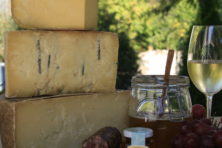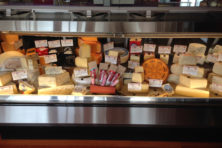The Cheese Insider
- Share
- Tweet
- Pin
- Share
Wisconsin has had a long history of immigration from Italy. The small, picturesque village of Genoa in Vernon County (western Wisconsin) was settled by Italian immigrants in the 1850s, many of whom worked in the nearby lead mines. Northern Wisconsin also drew a large number of Italians during the same period, mostly to work in the iron mines. Lured by the promise of jobs in the mills and factories of Milwaukee the number of Italians in Wisconsin continued to grow through the 1920s.
The Italians brought their love of cooking and cheesemaking to Wisconsin. The varieties of cheeses they were familiar with back in Italy were asiago, mascarpone, mozzarella, Parmesan, provolone, ricotta, and Romano. It wasn’t long after their arrival that all these great cheeses could be found in the homes of the Italian immigrants. They shared their cheesemaking skills and found a great source of milk here in Wisconsin.
• Asiago hails from Alps of northern Italy in a region known as the Asiago High Plateau. Historians claim that that cheese was first developed around AD 1000. This cheese is often described as a cross between sharp white cheddar and Parmesan. This cheese makes a great table cheese, low in fat, and high in protein, and pairs well with all types of fruits and nuts. When it is shredded it cooks very well, especially in baked dishes.
• Mascarpone comes from the Lombardy region of Italy. This rich, creamy white cheese is especially good in desserts, mixed with fruits or chocolate. Mascarpone has a buttery taste with a smooth, thick texture. This cheese is very good for all types of cooking, not just desserts. It pairs very well with any dry sparkling wine.
• Mozzarella is really a generic term to describe Italian style fresh cheese made by a process called pasta filata, where the curds are dipped in hot water and then stretched, kneaded, and cut to form balls or logs. Mozzarella was “discovered” by GIs serving in Italy during World War II. Today mozzarella is the second most popular cheese sold in America. Wisconsin makes more of it than any other cheese, over 650 million pounds a year. The majority of this cheese ends up on pizzas, although serving it fresh in antipasto salads, or simply with fresh tomatoes and basil, makes for a great dish. Light red wines or white wines like Pinot Grigio, Chardonnay, or Sauvignon Blanc all pair well with mozzarella.
• Parmesan cheese dates back to the twelfth century where it was developed by Benedictine and Cistercian monks near Italy’s Po River valley. Parmesan became legendary, used as a bartering tool for popes, kings and rulers of Italy.
Parmesan is pale yellow with sweet, nutty flavors that intensify with aging. The really good Parmesan cheeses are aged for over a year, some three years plus. It is made with part-skim milk, and is naturally low in fat. It’s hard, granular texture is perfect for grading or shredding over everything from pastas to soups and salads.
• Provolone is very similar to mozzarella in the way that it is made, but this cheese will be aged. Originally it was bound in a bag and hung from the ceiling of aging rooms. Tradionally, provolone has a slightly smoky flavor, a result of the wood fires used in Italian curing rooms. The Wisconsin cheesemakers that produce this cheese make both smoked and unsmoked provolone. This cheese comes in all shapes and sizes’, including what is known as a “Giganti,” a 600-pound, 7-foot giant. For cooking this cheese is very versatile. It can be used in pizza, lasagnas, and flavorful casseroles. Provolone pairs very well with Beaujolais, and any really good lager beer, of which Wisconsin has an abundance.
• Romano cheese is named for the city of its origin: Rome. There are many types of this cheese, Pecorino Romano is made from the milk of sheep and is tangy and somewhat sharp. Caprino Romano is made from goat’s milk and is extremely sharp. Vacchino Romano is a very mild cow’s milk version. Most Romano made in Wisconsin comes from cows milk, although we are seeing more traditional varieties being made by the “new” breed of cheesemakers. This cheese is aged at least 5 months and has a slightly higher fat content than Parmesan. This cheese can be used in cooking in place of Parmesan, and is a good table cheese served with fruits and nuts. Try good red wines such as Merlot, Zinfandel or Chianti or beer with this unique cheese.
• Ricotta is a soft cheese made with whey, the liquid by-product of cheese. The name Ricotta which means “cooked twice” in Italian, refers to the second processing of the liquid, when cheesemakers add lactic acid or vinegar and reheat. Ricotta is snowy white and has the consistency of cottage cheese. It is naturally low in fat but has a rich but mild slightly sweet flavor. Ricotta is a great cooking cheese, especially in classic Italian dishes such as lasagna, manicotti and cannelloni. This cheese can also be used in a variety of desserts, including sweet cannelloni and even cheesecake.
Wisconsin has numerous cheesemakers that produce all the great Italian cheeses listed above including: BelGioioso near Green Bay, Sartori in Antigo, Park Cheese in Fond du Lac, and Crave Brothers of Waterloo just to name a few. Many of the new artisan varieties of Italian style cheese are being produced by a very talented group of cheesemakers who put their own spin on an old world favorite, be sure to give them a try.
Source: Wisconsin Cheese by Martin Hintz & Pam Percy, Globe Pequot, 2008.
Michael C. Thomas is co-owner of Schoolhouse Artisan Cheese with his wife Janice. With locations in Ellison Bay and Egg Harbor, they aim to bring the best of Wisconsin artisan cheeses to Door County, and with “The Cheese Insider” Michael hopes to bring all things cheese to readers of the Pulse. If you have a question for “The Cheese Insider” please email it to [email protected].




